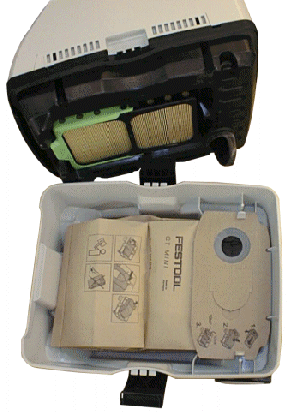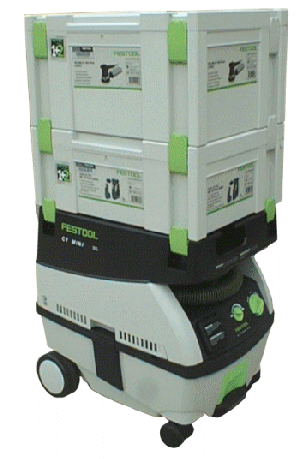|
|
|
| Description The CT Mini is the smallest vacuum made by Festool. Basically it is a diminutive and less expensive version of the larger Festool models but it has many of the features of the larger units. Aside from the differences dictated by size and price, the Mini shares all the same great qualities of the larger units. Instead of dwelling on these qualities (it would basically be a repeat of the CT22 review), I'll focus on the items that make the Mini different from the rest of the lineup. |
 |
| In Use This vacuum like its larger brethren supports the stacking systainers; the Mini is a little smaller of course but not noticeably so when stacked with several systainers. I suspect the "systainer" load rating is less also but it ought to handle a reasonable amount of them. Unlike the larger units the electrical cord and hose (which is permanently attached) is stored coiled inside an area provided in the top of the unit. This means that one must detach any systainer to get to the cord and hose before use. In a way the design aspect of this is nice, the cord isn't going to come loose during transport and you aren't able to forget the hose either. It is more inconvenient to stow them away or get to them initially. The hose supplied is the same long length (matches the Festool tool cord length) and anti static design. The systainers are latched to the top using four clips instead of two. The wheels on the Mini are smaller as well. In a relatively clean environment they allow the unit to roll around pretty well, not as well as one with larger wheels though. The "kick-stand" is on the front of the unit and very easy to operate. The larger vacuums have wheel locks which are less visible by comparison. I think the kick-stand is more accessible and a little bit better design. |
|
 |
The Mini is a two piece design. By flipping two clips on either
side the top is removed to access the filters and dust bin. The larger vacuums are
clamshell design that do not come apart. The Mini uses a single secondary filter but does
not have the external flipper" fingers of the CT22 to remove any dust cake on the
filter. At xxxxx the capacity is small as one would suspect; whether it is too small
depends upon your application. The controls are all front mounted and easy to use. Like the other vacuums it has the automatic power tool outlet and variable speed. Also like the larger units, once you have used these features you will become addicted to them and regard other vacuums without them as barbaric. The hose size is a little smaller (22mm vs 25mm) than the other units but the end is the same so it works with all the Festool vac connections. The suction power is also a little reduced (20kPa vs 23kPa for the CT22) but seems adequate on the tools I tried it with. The power outlet socket is also rated at half the power of the larger units, 1200 watts. |
| Summary The only drawback to the CT Mini is that it takes more time to store and access the cord and hose. Otherwise it is a compact machine that shares most of the high-end features of the larger Festool units. To me it seems that the Mini would be best suited for use where portability, small capacity, and in situations where it will be connected to a power tool most of the time. If you need something with a little more capacity and can travel across rougher terrain, the CT22 or CT33 would probably be more suitable. I've been using the CT22 as my "shop tool" dust collector, it's practically hard installed in my shop and I use it particularly with the Festool router and all my sanders. Now that I've used the Mini I can see how this unit might be better suited to a task such as this. It occupies less valuable shop space, is less expensive, and has all the power needed. I heartily recommend the Festool vacuums that I have, I use them frequently; my dilemma now is which to use. |
 |
In the interest of full disclosure Festool provided this product to facilitate this review.
|